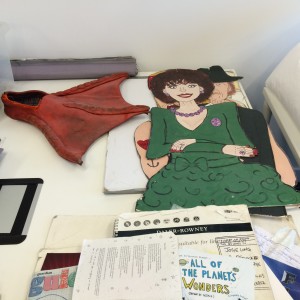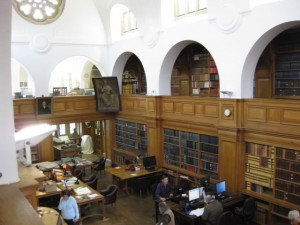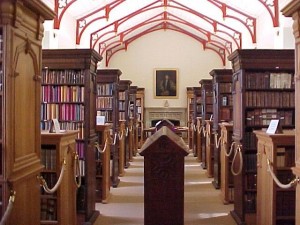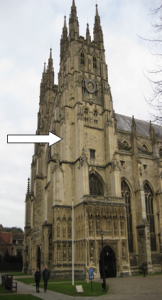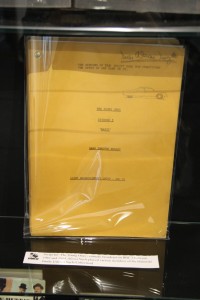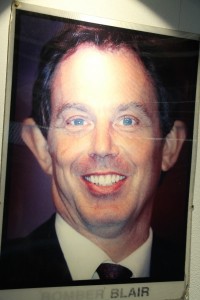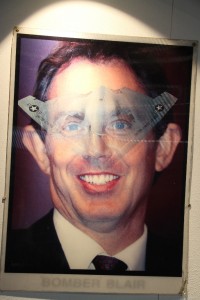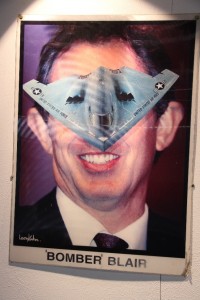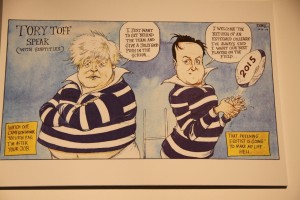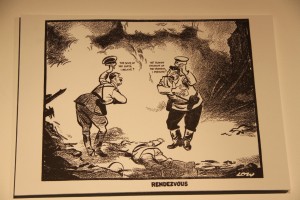Christine Holzapfel discusses her experiences of working with Special Collections & Archives whilst on an Erasmus+ placement in the Templeman Library.
As part of my 5 weeks Erasmus+ Work Placement at the Templeman Library I had some insights into the Special Collections & Archives department and the Canterbury Cathedral Library and Archives.
Craxton Theatre programmes and Foulkes Theatre flyers
My first task in Special Collections was to insert information about some Craxton Theatre programmes and Foulkes Theatre flyers into an Excel spreadsheet. I had to check for duplicates in our catalogue LibrarySearch and see if the archive has any more documents about the particular productions represented by the programmes and flyers. This information will be added to the catalogue to make it easier for researchers to find information about particular plays and theatres.
The store
I was shown the Special Collections & Archives store in the basement of the East Wing. It was really impressive to see all these specific collections – the mix of books, documents, photos and objects.
Rochester Cathedral Collection
With guidance from a colleague I catalogued a rare book from the Rochester Cathedral Collection. Most interesting here was that much more data was recorded than with „normal“ books. For example, things like bookplates, handwritten remarks, everything that is written on the title page and also every single illustrator will be given an entry into the record, because someone might search for it.
British Stand-Up Comedy Archive
As the British Stand-Up Comedy Archive was getting a new collection in from Josie Long (Comedian), I helped to unpack and sort the documents and objects. There were programmes and requisites of her shows, which gave a well-rounded overview of the professional work of a comedian.
Josie Long Collection
Digitisation
Also I have been shown the digitisation process of audio cassettes and photos. The audio cassettes are transfered into a digital file with the aid of a special programme and the appropriate equipment. Digitisation is a really important and ongoing process to keep the content of out of date media accessible.
Public Lending Rights Archive
Another collection that I have been working with was the “Public Lending Rights Archive”. This is a newly received collection, which required important basic conservation work in order to preserve it. This involved removing rusty paperclips/staples and replacing them with brass paperclips. Finally the documents were placed in archival acid-free folders.
Canterbury Cathedral Library and Archives
A „special highlight“ during my time in Special Collections & Archives was the visit to the Canterbury Cathedral Library and Archives.
The Reading Room (Canterbury Cathedral Archives)
In the archive
Together with the archivist I supervised a school class. They were given questions to 6 historic documents, which they got as facsimiles. In the end the students were shown the original precious documents.
Collections
I had the chance to do some workshadowing at the issues desk and to find out what kind of collections the Cathedral Archive possesses. It holds a wealth of manuscripts, photographs, maps and other records dating back to the late 8th century. Interesting is that there are not only religious inheritances (like e. g. central records of the Diocese of Canterbury) as you would expect, but also records of numerous local individuals, families, organisations, businesses, Parish Councils as well as local hospitals, mostly of the Canterbury area. I found it amazing that a lot of the historic documents have been already digitised and can be explored online and free of charge! on the archive homepage.
The Library
Two of the staff members gave me a guided tour through the Archive and the Library. The old library is really beautiful! It contains about 30,000 books and pamphlets printed before 1900, an expanding collection of 20,000 books and serials published in the 20th/21st centuries. The Collections are particularly rich in books on church history, older theology, national and local history, travel, natural science, medicine and the anti-slavery movement.
Canterbury Cathedral Library (http://www.pinterest.com)
The book stores
In the buildings around the cathedral are several book stores. But one book store you did not expect to be one. It is the cathedral itself! In one corner of the cathedral (left side beside the main entrance) is on the upper floor a book store. A small staircase inside leads to the store. This was a real surprise!
The book store inside the cathedral
The Preservation Studio
At the end of the day at Canterbury Cathedral Library and Archives I was shown the Preservation Studio and some of the work which has been conducted on historic books. People who are working in this area are, for me, always like artists. It is simply incredible how they are able to restore books (or documents) which are partly really heavily damaged (for whatever reason) and make them look like they were new.
Conclusion
All in all my time in the Special Collections & Archives at the Templeman Library (and of course the visit to (and of course the visit to Canterbury Cathedral Library and Archives) was a very interesting and unique experience. I am glad that I had the opportunity to get an insight into the Special Collections department with its various collections.

